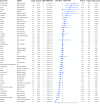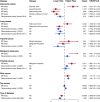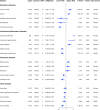Association between genetically proxied glucosamine and risk of cancer and non-neoplastic disease: A Mendelian randomization study
- PMID: 38993479
- PMCID: PMC11236616
- DOI: 10.3389/fgene.2024.1293668
Association between genetically proxied glucosamine and risk of cancer and non-neoplastic disease: A Mendelian randomization study
Erratum in
-
Correction: Association between genetically proxied glucosamine and risk of cancer and non-neoplastic disease: a mendelian randomization study.Front Genet. 2025 Aug 7;16:1660021. doi: 10.3389/fgene.2025.1660021. eCollection 2025. Front Genet. 2025. PMID: 40852166 Free PMC article.
Abstract
Introduction: Observational investigations have examined the impact of glucosamine use on the risk of cancer and non-neoplastic diseases. However, the findings from these studies face limitations arising from confounding variables, reverse causation, and conflicting reports. Consequently, the establishment of a causal relationship between habitual glucosamine consumption and the risk of cancer and non-neoplastic diseases necessitates further investigation.
Methods: For Mendelian randomization (MR) investigation, we opted to employ single-nucleotide polymorphisms (SNPs) as instruments that exhibit robust associations with habitual glucosamine consumption. We obtained the corresponding effect estimates of these SNPs on the risk of cancer and non-neoplastic diseases by extracting summary data for genetic instruments linked to 49 varied cancer types amounting to 378,284 cases and 533,969 controls, as well as 20 non-neoplastic diseases encompassing 292,270 cases and 842,829 controls. Apart from the primary analysis utilizing inverse-variance weighted MR, we conducted two supplementary approaches to account for potential pleiotropy (MR-Egger and weighted median) and assessed their respective MR estimates. Furthermore, the results of the leave-one-out analysis revealed that there were no outlying instruments.
Results: Our results suggest divergence from accepted biological understanding, suggesting that genetically predicted glucosamine utilization may be linked to an increased vulnerability to specific illnesses, as evidenced by increased odds ratios and confidence intervals (95% CI) for diseases, such as malignant neoplasm of the eye and adnexa (2.47 [1.34-4.55]), benign neoplasm of the liver/bile ducts (2.12 [1.32-3.43]), benign neoplasm of the larynx (2.01 [1.36-2.96]), melanoma (1.74 [1.17-2.59]), follicular lymphoma (1.50 [1.06-2.11]), autoimmune thyroiditis (2.47 [1.49-4.08]), and autoimmune hyperthyroidism (1.93 [1.17-3.18]). In contrast to prior observational research, our genetic investigations demonstrate a positive correlation between habitual glucosamine consumption and an elevated risk of sigmoid colon cancer, lung adenocarcinoma, and benign neoplasm of the thyroid gland.
Conclusion: Casting doubt on the purported purely beneficial association between glucosamine ingestion and prevention of neoplastic and non-neoplastic diseases, habitual glucosamine ingestion exhibits dichotomous effects on disease outcomes. Endorsing the habitual consumption of glucosamine as a preventative measure against neoplastic and non-neoplastic diseases cannot be supported.
Keywords: Mendelian randomization; cancer risk; causality; glucosamine; single-nucleotide polymorphisms.
Copyright © 2024 Wu, Che, Zhang, Xiong, Shu, Jiang, Li, Guo, Qiao, Li, Li, Chang, Zhang, Zhang, Qiu, Xi, Li, Chen, Ye and Zhang.
Conflict of interest statement
The authors declare that the research was conducted in the absence of any commercial or financial relationships that could be construed as a potential conflict of interest.
Figures




References
-
- Bosmann H. B. (1971). Inhibition of protein, glycoprotein, ribonucleic acid and deoxyribonucleic acid synthesis by D-glucosamine and other sugars in mouse leukemic cells L5178Y and selective inhibition in SV-3T3 compared with 3T3 cells. Biochim. Biophys. Acta 240 (1), 74–93. 10.1016/0005-2787(71)90515-6 - DOI - PubMed
LinkOut - more resources
Full Text Sources

